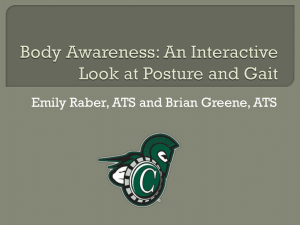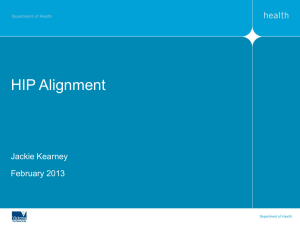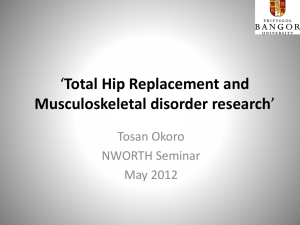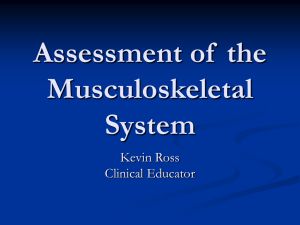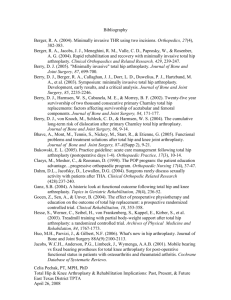PowerPoint PresentationR-THA PowerPoint Presentation
advertisement
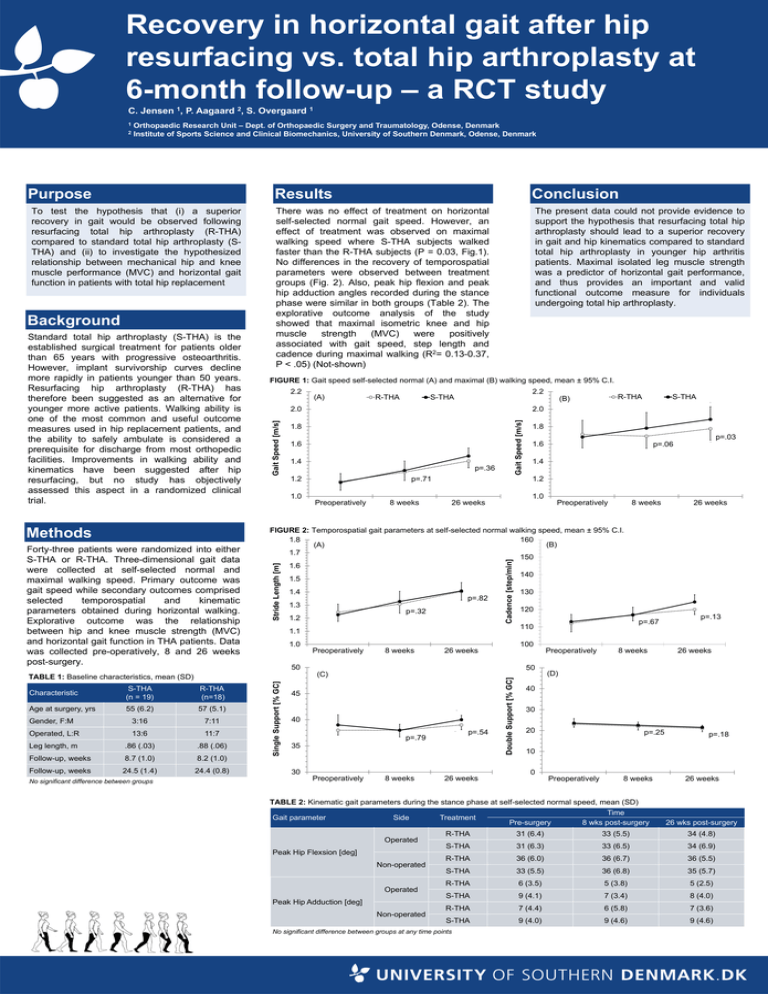
Recovery in horizontal gait after hip resurfacing vs. total hip arthroplasty at 6-month follow-up – a RCT study C. Jensen 1, P. Aagaard 2, S. Overgaard 1 Orthopaedic Research Unit – Dept. of Orthopaedic Surgery and Traumatology, Odense, Denmark 2 Institute of Sports Science and Clinical Biomechanics, University of Southern Denmark, Odense, Denmark 1 Results Methods Forty-three patients were randomized into either S-THA or R-THA. Three-dimensional gait data were collected at self-selected normal and maximal walking speed. Primary outcome was gait speed while secondary outcomes comprised selected temporospatial and kinematic parameters obtained during horizontal walking. Explorative outcome was the relationship between hip and knee muscle strength (MVC) and horizontal gait function in THA patients. Data was collected pre-operatively, 8 and 26 weeks post-surgery. FIGURE 1: Gait speed self-selected normal (A) and maximal (B) walking speed, mean ± 95% C.I. 2.2 R-THA S-THA 1.4 p=.36 1.2 Age at surgery, yrs 55 (6.2) 57 (5.1) Gender, F:M 3:16 7:11 Operated, L:R 13:6 11:7 Leg length, m .86 (.03) .88 (.06) Follow-up, weeks 8.7 (1.0) 8.2 (1.0) Follow-up, weeks 24.5 (1.4) 24.4 (0.8) * 8 weeks p=.03 1.6 p=.06 * 1.4 1.2 p=.71 Preoperatively 1.8 1.0 26 weeks Preoperatively 8 weeks 26 weeks FIGURE 2: Temporospatial gait parameters at self-selected normal walking speed, mean ± 95% C.I. 1.8 160 (B) (A) 1.7 150 1.6 140 1.5 1.4 p=.82 1.3 p=.32 1.2 1.0 120 Preoperatively 8 weeks 100 26 weeks 50 50 45 * 40 * p=.79 p=.54 35 30 130 p=.67 110 1.1 Single Support [% GC] Characteristic R-THA (n=18) Gait Speed [m/s] 1.6 (C) S-THA (n = 19) S-THA 2.0 1.8 1.0 R-THA (B) 2.0 TABLE 1: Baseline characteristics, mean (SD) No significant difference between groups (A) 2.2 Cadence [step/min] Standard total hip arthroplasty (S-THA) is the established surgical treatment for patients older than 65 years with progressive osteoarthritis. However, implant survivorship curves decline more rapidly in patients younger than 50 years. Resurfacing hip arthroplasty (R-THA) has therefore been suggested as an alternative for younger more active patients. Walking ability is one of the most common and useful outcome measures used in hip replacement patients, and the ability to safely ambulate is considered a prerequisite for discharge from most orthopedic facilities. Improvements in walking ability and kinematics have been suggested after hip resurfacing, but no study has objectively assessed this aspect in a randomized clinical trial. The present data could not provide evidence to support the hypothesis that resurfacing total hip arthroplasty should lead to a superior recovery in gait and hip kinematics compared to standard total hip arthroplasty in younger hip arthritis patients. Maximal isolated leg muscle strength was a predictor of horizontal gait performance, and thus provides an important and valid functional outcome measure for individuals undergoing total hip arthroplasty. Preoperatively 8 weeks 26 weeks Double Support [% GC] Background Conclusion There was no effect of treatment on horizontal self-selected normal gait speed. However, an effect of treatment was observed on maximal walking speed where S-THA subjects walked faster than the R-THA subjects (P = 0.03, Fig.1). No differences in the recovery of temporospatial parameters were observed between treatment groups (Fig. 2). Also, peak hip flexion and peak hip adduction angles recorded during the stance phase were similar in both groups (Table 2). The explorative outcome analysis of the study showed that maximal isometric knee and hip muscle strength (MVC) were positively associated with gait speed, step length and cadence during maximal walking (R2= 0.13-0.37, P < .05) (Not-shown) Gait Speed [m/s] To test the hypothesis that (i) a superior recovery in gait would be observed following resurfacing total hip arthroplasty (R-THA) compared to standard total hip arthroplasty (STHA) and (ii) to investigate the hypothesized relationship between mechanical hip and knee muscle performance (MVC) and horizontal gait function in patients with total hip replacement Stride Length [m] Purpose Preoperatively 8 weeks p=.13 26 weeks (D) 40 30 20 p=.25 p=.18 10 0 Preoperatively 8 weeks 26 weeks TABLE 2: Kinematic gait parameters during the stance phase at self-selected normal speed, mean (SD) Gait parameter Side Operated Peak Hip Flexsion [deg] Non-operated Operated Peak Hip Adduction [deg] Non-operated Pre-surgery Time 8 wks post-surgery 26 wks post-surgery R-THA 31 (6.4) 33 (5.5) 34 (4.8) S-THA 31 (6.3) 33 (6.5) 34 (6.9) R-THA 36 (6.0) 36 (6.7) 36 (5.5) S-THA 33 (5.5) 36 (6.8) 35 (5.7) R-THA 6 (3.5) 5 (3.8) 5 (2.5) S-THA 9 (4.1) 7 (3.4) 8 (4.0) R-THA 7 (4.4) 6 (5.8) 7 (3.6) S-THA 9 (4.0) 9 (4.6) 9 (4.6) Treatment No significant difference between groups at any time points

